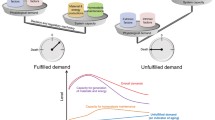Abstract
We consider a population where every individual has a unique lifespan. After expiring of its lifespan the individual has to leave the population. A realistic approach to describe these lifespans is by a continuous distribution. Such distributed lifespan models (DLSMs) were introduced earlier in the indirect response context and consist of the mathematical convolution operator to describe the rate of change. Therefore, DLSMs could not directly be implemented in standard PKPD software. In this work we present the solution representation of DLSMs with and without a precursor population and an implementation strategy for DLSMs in ADAPT , NONMEM and MATLAB . We fit hemoglobin measurements from literature and investigate computational properties.




Similar content being viewed by others
References
Krzyzanski W, Woo S, Jusko WJ (2006) Pharmacodynamic models for agents that alter production of natural cells with various distributions of lifespans. J Pharmacokinet Pharmacodyn 33(2):125–166
Freise K, Widness J, Schmidt R, Veng-Pedersen P (2008) Modeling time variant distributions of cellular lifespans: increases in circulating reticulocyte lifespans following double phlebotomies in sheep. J Pharmacokinet Pharmacodyn 35(3):285–323
Ramakrishnan R, Cheung WK, Wacholtz MC, Minton N, Jusko WJ (2004) Pharmacokinetic and pharmacodynamic modeling of recombinant human erythropoietin after single and multiple doses in healthy volunteers. J Clin Pharmacol 44:991–1002
Ait-Oudhia S, Scherrmann JM, Krzyzanski W (2010) Simultaneous pharmacokinetics/pharmacodynamics modeling of recombinant human erythropoietin upon multiple intravenous dosing in rats. J Pharmacol Exp Ther 334:897–910
D’Argenio DZ, Schumitzky A, Wang X (2009) ADAPT 5 user’s guide: pharmacokinetic/pharmacodynamic systems analysis software. Biomedical Simulations Resource, Los Angeles
Beal S, Sheiner LB, Boeckmann A, Bauer RJ (2009) NONMEM user’s guides. Icon Development Solutions, Ellicott City
MATLAB Release (2012) The MathWorks, Inc., Natick
Nichols B, Shrestha RP, Horowitz J, Hollot CV, Germain MJ, Gaweda AE, Chait Y (2011) Simplification of an erythropoiesis model for design of anemia management protocols in end stage renal disease. In: 33rd Annual international conference of the IEEE EMBS Boston, Massachusetts, USA
Atkinson K (1989) An introduction to numerical analysis, 2nd edn. Wiley, New York
Thomas GB, Finney RL (1996) Calculus and analytic geometry, 9th edn. Addison-Wesley, Reading
Marshall AW, Olkin I (2007) Life distributions. Springer, New York
Bebbinton M, Lai CD, Zitikis R (2007) Modeling human mortality using mixtures of bathtub shaped failure distributions. J Theor Biol 245(3):528–538
Korell J, Coulter CV, Duffull SB (2011) A statistical model for red blood cell survival. J Theor Biol 268(1):39–49
Press WH, Teukolsky SA, Vetterling WT, Flannery BP (1992) Numerical recipes in Fortran 77, the art of scientific computing, 2nd edn. Cambridge University Press, New York
Krzyzanski W (2011) Interpretation of transit compartments pharmacodynamic models as lifespan based indirect response models. J Pharmacokinet Pharmacodyn 38(2):179–204
Koch G, Schropp J (2012) General relationship between transit compartments and lifespan models. J Pharmacokinet Pharmacodyn 39(4):343–355
Acknowledgments
The present project is supported by the National Research Fund, Luxembourg, and cofunded under the Marie Curie Actions of the European Commission (FP7-COFUND).
Author information
Authors and Affiliations
Corresponding author
Electronic supplementary material
Appendices
Appendices
Appendix 1
To estimate the amount of individuals at the initial population state N(0) for the DLSM (5), (6) we define the production term
Then the appropriate initial value N(0) is determined by the claim \(\lim \nolimits_{t \rightarrow \infty} N(t) = 0.\) Substituting (24) into (5) results in
The general solution of (25) reads
Then
Using (24)
Appendix 2
We consider a constant past k in (t) = \(k_{in}^{0}\) for t ≤ 0 and obtain for the initial values
and
Appendix 3
To estimate the amount M(0) of the follow-up population for the DPLSM (7), (8) a similar approach as in Appendix 1 is applied. We define the production
and use the condition \(\lim \nolimits_{t \rightarrow \infty} M(t) = 0\) to determine M(0). Substituting (26) into (7) results in
and therefore,
Appendix 4
Differentiation of (10) with respect to time t gives
With (10) we obtain for the initial value
Appendix 5
Generally, for an arbitrary continuous function f, the trapezoidal rule reads
with the equidistant partition s j = τ 0 + (j − 1)h with \(h = \frac{\tau_{end}-\tau_0}{m}\) for j = 1,…,m + 1 of the lifespan interval [τ 0, τ end ].
Appendix 6
Differentiation of (13) with respect to time t gives
The inner integral in (29) could be written as
Substitution of (31) into (29) gives
For the initial value we obtain
Appendix 7
In the following we present the implementation of the trapezoidal rule for (10). Only additional functions and modified ADAPT subroutines are presented. For the complete code see the supplemental material.
Logarithm of the gamma function \(\Gamma(x)\) based on [14]:
 CDF L(x) of the WBD:
CDF L(x) of the WBD:
 Multiple dosing function for c(t):
Multiple dosing function for c(t):
 Production k
in
(t):
Production k
in
(t):
 Integrand in (10):
Integrand in (10):
 Trapezoidal rule:
Trapezoidal rule:
 The
ADAPT
subroutine
OUTPUT
calls the trapezoidal rule for the different dosing groups.
The
ADAPT
subroutine
OUTPUT
calls the trapezoidal rule for the different dosing groups.


Rights and permissions
About this article
Cite this article
Koch, G., Schropp, J. Solution and implementation of distributed lifespan models. J Pharmacokinet Pharmacodyn 40, 639–650 (2013). https://doi.org/10.1007/s10928-013-9336-y
Received:
Accepted:
Published:
Issue Date:
DOI: https://doi.org/10.1007/s10928-013-9336-y




